SPORTS INJURIES AND FITNESS IN TEENS
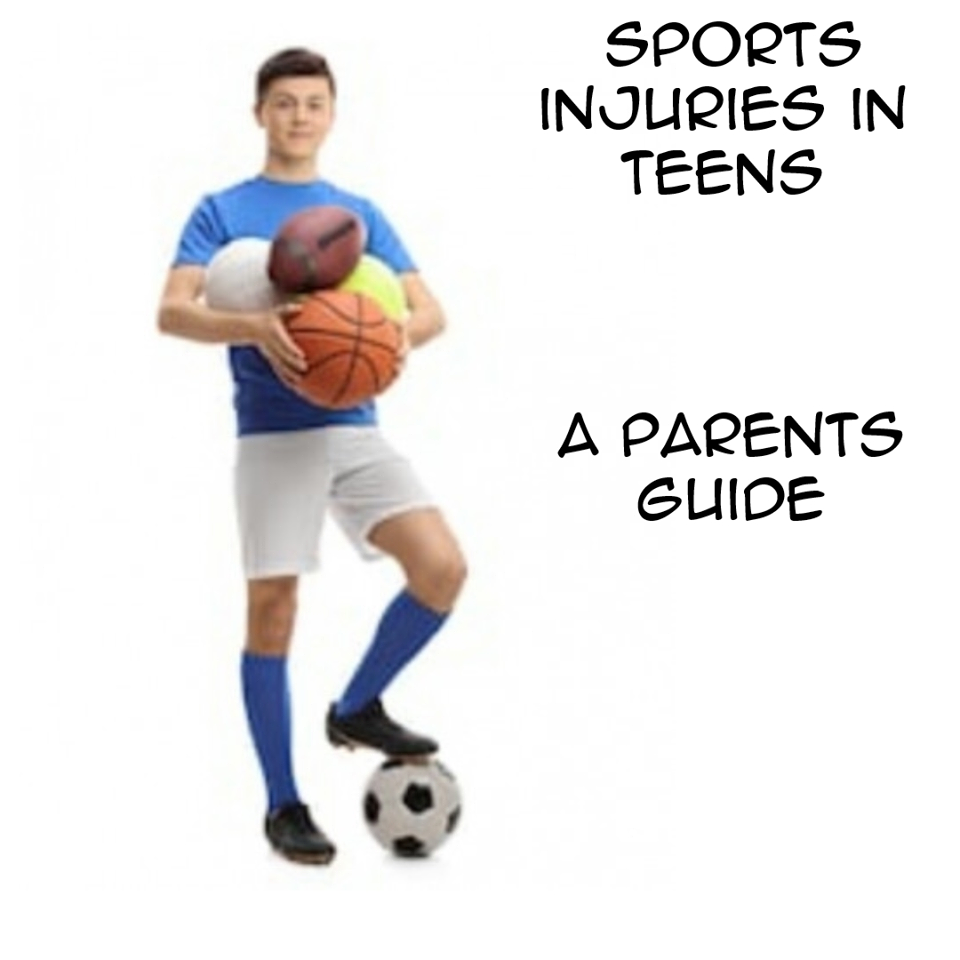
A parents job is not to produce a World Championship athlete, but to encourage their kids to become healthy adults and support them in making fitness a way of life. Teens should engage in 60 minutes of vigorous physical exercise each day. This series of posts will look at the benefits of teenagers playing sports, how puberty can influence sports injuries and how to reduce the risk of and deal with injuries. All sports have a risk of injury, but the benefits of sports participation outweigh the risks. While most teen injuries are due to overuse of a muscle, it is generally contact sports that carry the greatest risk of a traumatic injury.
BENEFITS OF TEENS PLAYING SPORTS:-
• learning cooperation and time management
• building relationships
• brings together teens from different backgrounds and communities
• keeping fit
• learning about sports nutrition
• boosts self confidence
• building leadership skills
• positive sport coaching may also encourage academic success
• gives teens and parents an opportunity to strengthen their bond
TYPES OF TRAINING:-
STRENGTH/RESISTANCE TRAINING
– tones and strengthens muscles by working against some kind of resistance, causing them to contract, and can build endurance. Micro tears are created in the muscle during resistance training and are replaced by new muscle tissue which helps the muscle become stronger.
Weight training may be done using:-
• Free Weights —eg dumbells, barbells, kettlebells. Free weights may require more strength than machines, so choosing an appropriate weight and using a spotter are essential
• Weight Machines — usually work a single muscle/smaller group of muscles
• Other Resistance Training – using your own bodyweight to provide resistance eg.push ups, resistance bands
When starting up any weight training you should talk to a fitness trainer and follow basic rules:- • Jog for five to ten minutes/ warm up exercises • Stretch after warming up • train 2-3 times a week maximum for the first few weeks • if you have to strain to lift, the weight is too heavy • you will feel sore after the first few weight-lifting sessions • only work one or two different muscle groups each workout • allow a day of rest for each muscle group after each workout • stretch and cool down after each workout to reduce soreness afterwards • pay attention to nutrition and ensure you're eating right • if you feel a sharp pain/ pop while exercising, stop immediately and consult a trainer/sports therapist/gp before continuing
FLEXIBILITY TRAINING
- flexibility allows movement of muscles and joints through the full range of motion and therefore helps reduce the risk of injury. Stretching should be done before and after other types of exercise but also needs to be done using the correct technique. Yoga, pilates and martial arts are also good ways to improve and maintain flexibility.
ENDURANCE TRAINING
– (aerobic fitness) endurance means how long you can perform an activity without fatigue. Aerobic exercise burns calories and fat, strengthens the heart and lungs, reduce the risk of diabetes, heart disease, and high blood pressure, all of which further improve your endurance. Aerobic exercise can be done on days where no weight training takes place.
Good aerobic fitness activities for teens include:-
• walking
• step aerobics
• water aerobics
• swimming
• rowing
• running
• cycling
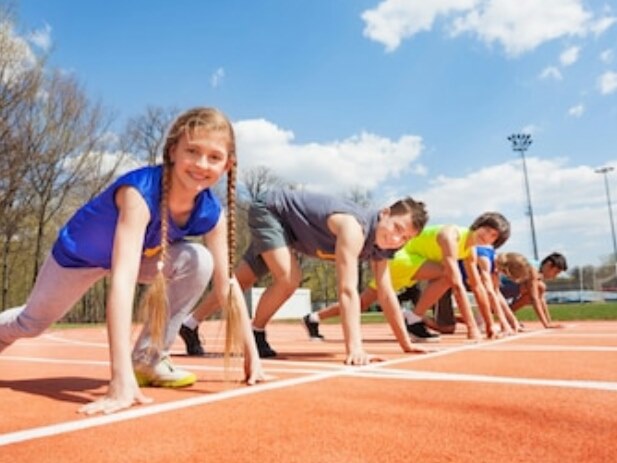
TIPS FOR PREVENTING SPORTS INJURIES:-
• use correct technique
• warm up and cool down
• strengthen muscles specific to your sport through conditioning exercises
• increase flexibility through regular stretching
• training too much
• not wearing the correct footwear
• not using the correct safety equipment eg. pads (neck, shoulder, elbow, chest, knee, shin), helmets, mouthpieces, face guards, protective cups, and eyewear
• follow the safety rules of the game
• ensuring balanced sports nutrition – to maintain blood glucose levels eat before, during and after sports. Do not fast.
• ensuring adequate hydration – the body loses fluid during sport and can dehydrate
• rapid growth during puberty
• take at least 1 day off per week to allow the body to recover
• do not play if in pain
THERE ARE 2 TYPES OF SPORTS INJURIES:-
- ACUTE TRAUMATIC INJURIES – eg.fractures, sprains and strains, concussions, and cuts, due to a traumatic blow such as a football tackle or wiping out while skateboarding.
- OVERUSE INJURIES - chronic injuries that occur over time due to repetitive movements eg.stress fractures and tendonitis training, which may occur in throwing sports.
COMMON TYPES OF SPORTS INJURIES IN TEENS:-
GROIN INJURIES - Increased risk of stress fractures in the groin in teenage girls - Increased risk of avulsion fractures in teenage athletes due to pelvic growth plates not yet having solidified - Common in sports such as football, hockey, rugby, basketball and gymnastics which involve sudden stops/starts
ANKLE SPRAINS - one of the most common sport injuries - a twisting injury that damages the ligaments of the ankle - require a brief period of immobilization, followed by an exercise program and short rest from sports - in younger athletes the non-displaced growth plate fracture of the fibula, can mimic an ankle sprain
KNEE PAIN - Anterior knee pain is common in youth sports, particularly females - patellofemoral syndrome - considered an overuse injury due to overloading on the kneecap - often due to muscle imbalance and high activity levels in teens - physiotherapy will treat this condition
SHIN SPLINTS - inflammation of the tendons connecting the shin muscles to the tibia (shin bone) due to overloading
OSGOOD-SCHLATTER - a very specific type of knee pain - a traction injury on the apophyseal growth plate at the top of the shin bone (tibia), due to strong and relatively tight muscles which develop during puberty and high activity levels - pain and sometimes swelling can be felt directly over a bump at the bottom of the knee - treatment includes rest, stretching, ice, NSAIDs, and possibly a knee support
ACL TEARS - anterior cruciate ligament (ACL) stabilises the knee - ACL is torn during an uncontrolled twisting motion - almost always requires surgery in the young and active people - often involves damage to other structures in the knee, eg. the menisci (shock-absorbing cartilage) which is becoming more common in children due to early participation in sports such as football with sudden stops and turns - should wait at least 7-9 months before returning to sport
LITTLE LEAGUER'S ELBOW - considered the classic overuse injury - include any pain around the elbow during excessive throwing - recover with rest, stretching and proper throwing form on return to sport - may require surgery in some cases
SHOULDER DISLOCATION - Teen males playing contact sports such as football, hockey, rugby are a risk factor for shoulder dislocations
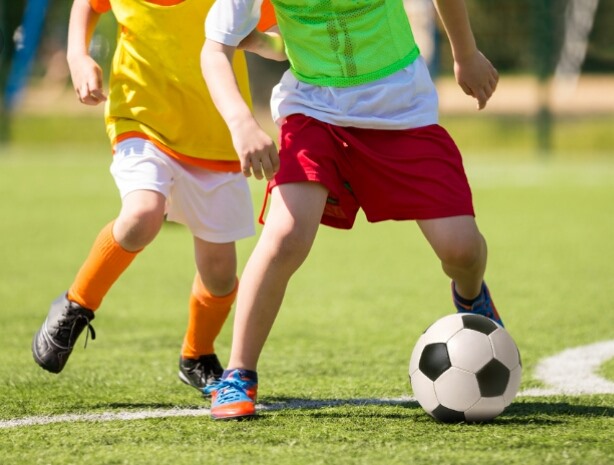
FOOT AND ANKLE INJURIES – susceptible to sports injuries in those with flat feet, high arches and other anatomical foot differences, as well as wearing the incorrect shoes for any sports that involves a lot of running
HEAD AND NECK INJURIES – most common in contact sports eg. football or sports with a risk of falling eg.horseriding. Any impact or shaking of the head can cause concussion, contusions, fractures and haematoma. Neck injuries eg whiplash, strains, sprains and fractures occur with sudden jerking movements of the head, and the person must not be moved until medical help arrives.
HAND AND WRIST INJURIES – any fall onto an outstretched arm or that forces the hand or fingers backward, or a direct impact, can cause these injuries, usually in contact sports or gymnastics
BACK INJURIES - caused by overexertion of back muscles during bending/twisting/lifting movements, usually in contact sports like rugby, or weightlifting, golf, gymnastics,
SEX ORGAN INJURIES- affect males more due to the organs being more exposed, although breast injuries are common in teen girls due to a collision being more painful if breast development causes tenderness
SPORTS RELATED EMOTIONAL STRESS - many coaches and parents place too much focus on winning rather then effort and sportsmanship, which places a teen under considerable pressure. The main goal is to have fun and learn lifelong physical activity skills.
SPORTS RELATED CONCUSSION All sport carries some risk, but football, lacrosse, basketball, hockey, and cheerleading have a higher incidence of concussions, some of which can be avoided through safe techniques and following the rules.
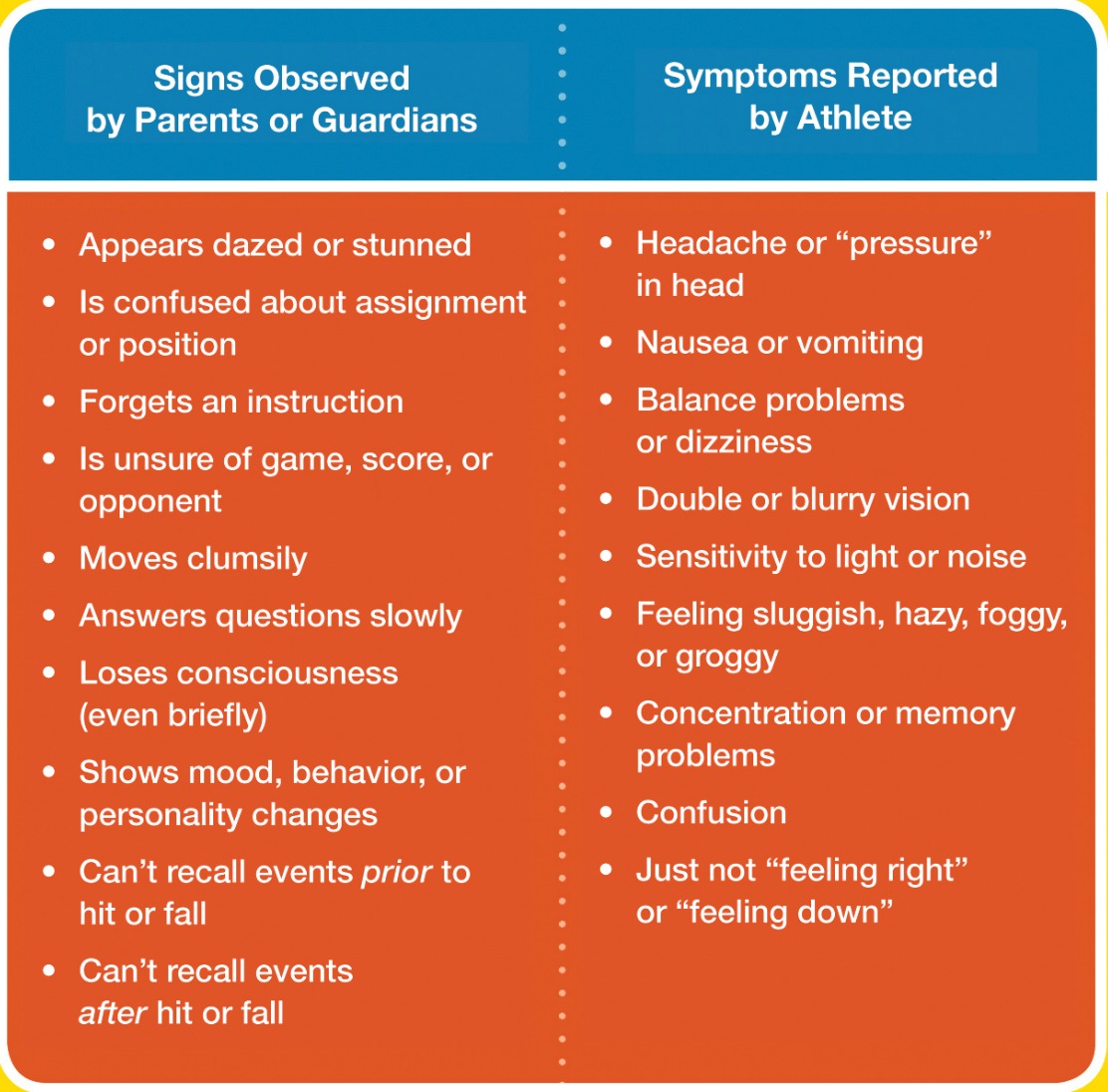
Head injuries should never be ignored and if one or more symptoms of concussion are present,sport should be avoided and medical advice sought as soon as possible. Athletes should also reduce their physical exertion and cognitive workload while recovering, which can take up to around 4 weeks. All things considered, the dangers of inactivity surpass the dangers of playing a sport. Aside from having fun and staying active, playing a sport can help your child develop leadership skills, self-confidence, and teamwork and deal with success and failure. In addition, by participating in sports, children often find exercise enjoyable and are more likely to establish lifelong exercise habits.
EFFECT OF PUBERTY ON SPORTS PERFORMANCE: What Parents Need to Know

Children seem to specialize in a single sport from an earlier age and train all year, which may benefit long term career/college goals but it is suggested by paediatricians that specializing in one sport should not happen before puberty, when teens go through a growth spurt, and this can affect their athletic performance. Increased muscle size and strength, and hormones, may boost athletic performance, but height and weight increase may temporarily affect balance and the centre of gravity during the growth spurt. This may cause a teen to appear clumsy, particularly in sports such as basketball or gymnastics which require balance. Even sports such as tennis or lacrosse may be affected by changes in arm length.
GROWTH PLATES Children's bones contain a cartilage growth plate which turns into bone once fully grown, and this is at its weakest during growth spurts. If fractured, by a fall or excessive impact, or subjected to repetitive stress, the bone may not develop properly. Even a gymnast who has had no injury, may suffer due to repetitive tumbling.
ACL INJURIES DURING PUBERTY The anterior cruciate ligament (ACL) is at risk of increased injury once a teen becomes taller and heavier, (12 - 13 years of age in girls and 14 - 15 years of age in boys),potentially affecting knee stability. Teenage girls use their muscles differently to boys during jumping and landing,and do not have increased muscle growth due to testosterone, so are at increased risk.
EARLY V LATE BLOOMER : Tips for Parents
Sports teams tend to group kids by age rather than development, and since not all teens go through puberty at the same time, their physical capacity and motor skills will not be matched. With 25% of height developing in puberty, the risk of injury increases during this growth - a late bloomer who may have the appearance of a 10 year old to be tackling an early bloomer who may seem like a 17 year old there will be safety issues. It’s not only the late bloomers who are vulnerable to injuries, however, as early bloomers may be selected for sports because of their height, but their bones are still developing.
Safety measures:-
• Ensure that protective items eg.shinpads, helmets, mouthguards, goggles, protective cups, shoes fit correctly
• coaches should enforce strict rules against actions which may encourage head, neck and spine injuries eg. headfirst sliding in baseball, head first hits or banned tackles
• setting an age restriction on particularly high risk sports eg. ice hockey, to allow for body development during puberty Injuries may also be more likely in co-ed, particularly contact sports, due to higher testosterone levels in boys making them stronger than girls of the same age.
While an early bloomer may be at an advantage because of their size, progress in sports should be based on correct skill and teams matched equally in terms of development, but unfortunately the emphasis that coaches place on winning, mean that this doesn’t always happen. Late bloomers, on the other hand, may be sidelined due to a lack of ability early on, meaning that they feel incompetent and give up sports all together
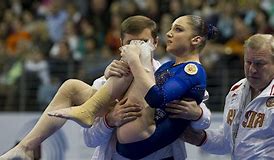
WHEN TO SEE A DOCTOR:-
Many overuse injuries, eg. tendonitis happen over time and often does not interfere with playing, which can cause delayed diagnosis and treatment, or worsening of the injury to something more serious.
• point tenderness over a bone
• pain is very bad
• pain is worse when you're active
• the injured area is swollen
• limping
• range of motion is limited
• pain continues for a week or more following an injury
• symptoms that do not go away after rest
• any condition that affects training
Types of conditions:-
ACUTE INJURIES – eg.sprains, strains, fractures, dislocations, growth plate separation, torn cartilage, bruises, cuts, scrapes, pinched nerves, herniated disks
SYMPTOMS – Pain, swelling, bruising, deformity, spasm, restricted or locking joint, instability, numbness, tingling, shooting pains or other symptoms that restrict sports/daily activity
WHEN TO SEE DR:-
• joint swelling/ locking / instability
• visible deformity in arms/legs/joints
• inability to fully move a joint/arm/leg
• inability to stand or walk
• back/neck pain-especially with numbness/ weakness/pain that runs down the arm/leg
• pain that does not go away
• pain that disrupts daily activity or sleep
OVERUSE INJURIES – eg.tendonitis, shin splints, stress fractures, growth plate problems like Osgood-Schlatter, Sever’s disease, or Little League elbow, bursitis, fasciitis, compartment syndrome, nerve entrapment, spondylolysis
SYMPTOMS – pain, tightness/popping/grinding in joints, mild/localized swelling, weakness, other symptoms that get worse with activity but go away with rest Symptoms will initially be noticeable after vigorous activity, but will gradually be seen during any activity.
WHEN TO SEE DR:-
• localized pain that worsens over time or with continued activity
• pain/swelling/stiffness/weakness that interferes with training
• pain or other symptoms that do not go away with treatments/rest
• pain that interferes with daily activity/disrupts sleep
MEDICAL CONDITIONS – eg. concussion
SYMPTOMS
-headache, disorientation, loss of consciousness, blurry vision, nausea, memory loss, dizziness, lethargy, agitation, vomiting, fatigue, moodiness
WHEN TO CHECK WITH DR:-
• if any of these symptoms develop after a head injury, see a doctor before returning to sport
Precautions should also be taken with conditions such as fever, abdominal pain, heat stroke which can cause dehydration
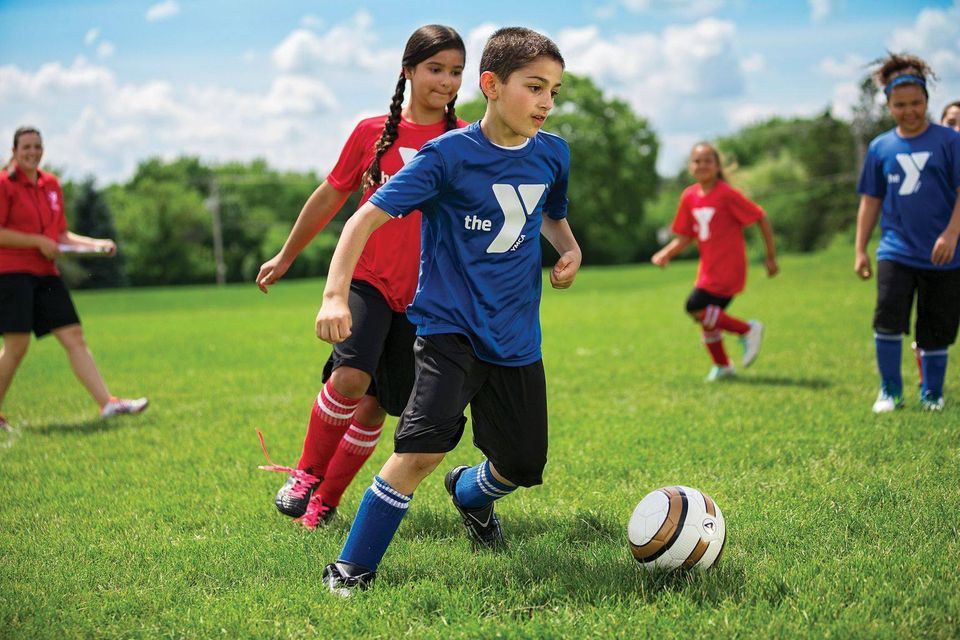
RETURN TO PLAY
• rehabilitation may include exercise, manual therapy and ultrasound/other technology to help relieve pain and promote healing
• may need new protective gear/athletic tape to protect the injured body part and provide extra support
• be sure to warm up before practice
• take it slow and gradually build back up to your preinjury level
• know your limits and stop right away if the injury site hurts
WHEN IS AN ATHLETE READY TO RETURN TO PLAY?
1)Diagnosis – determines the cause of the symptoms, treatment options, recovery time frame and expected level of recovery.
2) How does the condition affect performance? – ie. will it interfere with the athlete’s ability to play or adversely affect endurance, flexibility, strength, or coordination?
3) Will the condition get worse from playing? - the injured body part may become more vulnerable because it has been injured, so if return to play happens before a full recovery, the injury will get worse, eg. a stress fracture can become a complete fracture
4) What is the risk of secondary injury? - when athletes try to protect an injured area, they may expose other body parts to injury
5)Has treatment been effective? - Is there treatment available? Has treatment been carried out? How effective is the treatment? Are there any side effects of treatment? Has the treatment finished? Have the deficits from injury/illness been restored?
6) Can the sport/level of participation be modified to be safer? – eg. temporarily play another position without jeopardizing recovery, reducing the hours of practice, modifying the technique or equipment used to allow the athlete to continue to play?
7) Are there published guidelines that address the return-to-play decision?
8) Is there a disproportionately high risk for further injury? - if the injury further increases high risk of contact and endurance sports , it may be ill advised to play.
9) Is there informed consent? - return to play should not take place until all risks are understood and considered to be acceptable by the athlete/family/doctor
10) Does the athlete want to play? – if athletes do not want to return to sport, through fear of further injury, concern that they won’t play as well , loss of interest, burnout, then they should not be pressured into it.
